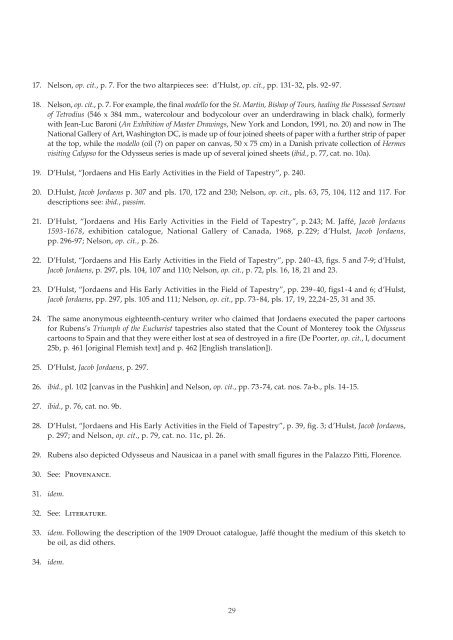Jacob-Jordaens-A-Rediscovered-Cartoon-for-a-Tapestry-Jean-Luc-Baroni
- No tags were found...
You also want an ePaper? Increase the reach of your titles
YUMPU automatically turns print PDFs into web optimized ePapers that Google loves.
17.<br />
18.<br />
19.<br />
20.<br />
21.<br />
22.<br />
23.<br />
24.<br />
25.<br />
26.<br />
27.<br />
28.<br />
29.<br />
30.<br />
31.<br />
32.<br />
33.<br />
34.<br />
Nelson, op. cit., p. 7. For the two altarpieces see: d’Hulst, op. cit., pp. 131-32, pls. 92-97.<br />
Nelson, op. cit., p. 7. For example, the final modello <strong>for</strong> the St. Martin, Bishop of Tours, healing the Possessed Servant<br />
of Tetrodius (546 x 384 mm., watercolour and bodycolour over an underdrawing in black chalk), <strong>for</strong>merly<br />
with <strong>Jean</strong>-<strong>Luc</strong> <strong>Baroni</strong> (An Exhibition of Master Drawings, New York and London, 1991, no. 20) and now in The<br />
National Gallery of Art, Washington DC, is made up of four joined sheets of paper with a further strip of paper<br />
at the top, while the modello (oil (?) on paper on canvas, 50 x 75 cm) in a Danish private collection of Hermes<br />
visiting Calypso <strong>for</strong> the Odysseus series is made up of several joined sheets (ibid., p. 77, cat. no. 10a).<br />
D’Hulst, “<strong>Jordaens</strong> and His Early Activities in the Field of <strong>Tapestry</strong>”, p. 240.<br />
D.Hulst, <strong>Jacob</strong> <strong>Jordaens</strong> p. 307 and pls. 170, 172 and 230; Nelson, op. cit., pls. 63, 75, 104, 112 and 117. For<br />
descriptions see: ibid., passim.<br />
D’Hulst, “<strong>Jordaens</strong> and His Early Activities in the Field of <strong>Tapestry</strong>”, p. 243; M. Jaffé, <strong>Jacob</strong> <strong>Jordaens</strong><br />
1593-1678, exhibition catalogue, National Gallery of Canada, 1968, p. 229; d’Hulst, <strong>Jacob</strong> <strong>Jordaens</strong>,<br />
pp. 296-97; Nelson, op. cit., p. 26.<br />
D’Hulst, “<strong>Jordaens</strong> and His Early Activities in the Field of <strong>Tapestry</strong>”, pp. 240-43, figs. 5 and 7-9; d’Hulst,<br />
<strong>Jacob</strong> <strong>Jordaens</strong>, p. 297, pls. 104, 107 and 110; Nelson, op. cit., p. 72, pls. 16, 18, 21 and 23.<br />
D’Hulst, “<strong>Jordaens</strong> and His Early Activities in the Field of <strong>Tapestry</strong>”, pp. 239-40, figs1-4 and 6; d’Hulst,<br />
<strong>Jacob</strong> <strong>Jordaens</strong>, pp. 297, pls. 105 and 111; Nelson, op. cit., pp. 73-84, pls. 17, 19, 22,24-25, 31 and 35.<br />
The same anonymous eighteenth-century writer who claimed that <strong>Jordaens</strong> executed the paper cartoons<br />
<strong>for</strong> Rubens’s Triumph of the Eucharist tapestries also stated that the Count of Monterey took the Odysseus<br />
cartoons to Spain and that they were either lost at sea of destroyed in a fire (De Poorter, op. cit., I, document<br />
25b, p. 461 [original Flemish text] and p. 462 [English translation]).<br />
D’Hulst, <strong>Jacob</strong> <strong>Jordaens</strong>, p. 297.<br />
ibid., pl. 102 [canvas in the Pushkin] and Nelson, op. cit., pp. 73-74, cat. nos. 7a-b., pls. 14-15.<br />
ibid., p. 76, cat. no. 9b.<br />
D’Hulst, “<strong>Jordaens</strong> and His Early Activities in the Field of <strong>Tapestry</strong>”, p. 39, fig. 3; d’Hulst, <strong>Jacob</strong> <strong>Jordaens</strong>,<br />
p. 297; and Nelson, op. cit., p. 79, cat. no. 11c, pl. 26.<br />
Rubens also depicted Odysseus and Nausicaa in a panel with small figures in the Palazzo Pitti, Florence.<br />
See: Provenance.<br />
idem.<br />
See: Literature.<br />
idem. Following the description of the 1909 Drouot catalogue, Jaffé thought the medium of this sketch to<br />
be oil, as did others.<br />
idem.<br />
29
















